The Effect of Bottom Ash Ball-Milling Time on Properties of Controlled Low-Strength Material Using Multi-Component Coal-Based Solid Wastes
Abstract
:1. Introduction
2. Experimental Programs
2.1. Materials
2.2. Mixture Proportions
2.3. CLSM Preparation and Testing Procedure
2.4. Microstructure Testing
3. Results and Discussion
3.1. Flowability
3.2. Bleeding
3.3. Density
3.4. Compressive Strength
3.5. Setting Time
3.6. Absorption and Porosity
3.7. Microstructure
4. Conclusions
- (1)
- The flowability, bleeding, compressive strength, setting time, density, porosity, and absorption of CLSM met the specification and requirements of ACI Committee 229. The flowability and bleeding of CLSM decreased with the increase in BA content and ball milling time. However, the flowability was still in the high flowability range, and the reduction in bleeding was favorable. Bleeding was reduced by 48% and 64% for BAI70 and BAII70, respectively. The density, porosity, and absorption of CLSM did not change significantly with the addition of BA and the change in ball-milling time. With the increase in BA content, the initial setting time and final setting time of CLSM declined significantly, and the final setting time of BAI70 and BAII70 decreased by 37% and 36%, respectively.
- (2)
- The addition of BA and the increase in ball-milling time improved the 3 d strength of CLSM. Compared with Blank, BAI70 and BAII70 increased by 48% and 93%, respectively, which was favorable for structural fills. With the increase in the mass ratio, the 7 d and 28 d strength showed a trend of first declining and then increasing, but the fluctuation was not remarkable. The RE values of all CLSM mixtures were all greater than 1, which is suitable for structural fills that require a higher strength.
- (3)
- It was observed in the SEM images that the BA-containing CLSM exhibited an open microstructure with high porosity. As revealed by XRD, with the rise in BA content, the quartz peaks of CLSM samples were enhanced, whereas the intensities of ettringite and C-S-H peaks were reduced.
- (4)
- The production of CLSM with coal-based solid wastes as raw materials is feasible in terms of engineering performance, cost, and environmental impact. In the future, research on cement-free CLSM for total solid wastes should be strengthened to further reduce costs. Additionally, considering the location, utilization rate, and economy of raw materials, the feasibility of large-scale production and application of the CLSM prepared in this work for underground filling should be discussed.
Author Contributions
Funding
Institutional Review Board Statement
Informed Consent Statement
Data Availability Statement
Acknowledgments
Conflicts of Interest
References
- ACI 229R-13; Report on Controlled Low-Strength Materials. American Concrete Institute: Farmington Hills, MI, USA, 2013.
- Somboonyanon, P.; Halmen, C. Seismic Behavior of Steel Pipeline Embedded in Controlled Low-Strength Material Subject to Reverse Slip Fault. J. Pipeline Syst. Eng. 2021, 12, 04021025. [Google Scholar] [CrossRef]
- Alizadeh, V. Analytical study for allowable bearing pressures of CLSM bridge abutments. Transp. Geotech. 2019, 21, 100271. [Google Scholar] [CrossRef]
- Do, T.M.; Kim, H.; Kim, M.; Kim, Y. Utilization of controlled low strength material (CLSM) as a novel grout for geothermal systems: Laboratory and field experiments. J. Build. Eng. 2020, 29, 101110. [Google Scholar] [CrossRef]
- Bassani, M.; Bertola, F.; Bianchi, M.; Canonico, F.; Marian, M. Environmental assessment and geomechanical properties of controlled low-strength materials with recycled and alternative components for cements and aggregates. Cem. Concr. Compos. 2017, 80, 143–156. [Google Scholar] [CrossRef]
- Mneina, A.; Soliman, A.M.; Ahmed, A.; El Naggar, M.H. Engineering properties of Controlled Low-Strength Materials containing Treated Oil Sand Waste. Constr. Build. Mater. 2018, 159, 277–285. [Google Scholar] [CrossRef]
- Lee, N.K.; Kim, H.K.; Park, I.S.; Lee, H.K. Alkali-activated, cementless, controlled low-strength materials (CLSM) utilizing industrial by-products. Constr. Build. Mater. 2013, 49, 738–746. [Google Scholar] [CrossRef]
- Hung, C.C.; Wang, C.C.; Wang, H.Y. Establishment of the Controlled Low-Strength Desulfurization Slag Prediction Model for Compressive Strength and Surface Resistivity. Appl. Sci. 2020, 10, 5674. [Google Scholar] [CrossRef]
- Do, T.M.; Kang, G.O.; GO, G.H.; Kim, Y.S. Evaluation of Coal Ash-Based CLSM Made with Cementless Binder as a Thermal Grout for Borehole Heat Exchangers. J. Mater. Civ. Eng. 2019, 31, 04019072. [Google Scholar] [CrossRef]
- Katz, A.; Kovler, K. Utilization of industrial by-products for the production of controlled low strength materials (CLSM). Waste Manag. 2004, 24, 501–512. [Google Scholar] [CrossRef]
- Xiao, R.; Polaczyk, P.; Jiang, X.; Zhang, M.M.; Wang, Y.H.; Huang, B.S. Cementless controlled low-strength material (CLSM) based on waste glass powder and hydrated lime: Synthesis, characterization and thermodynamic simulation. Constr. Build. Mater. 2021, 275, 122157. [Google Scholar] [CrossRef]
- Dueramae, S.; Sanboonsiri, S.; Suntadyon, T.; Aoudta, B.; Tangchirapat, W.; Jongpradist, P.; Pulngern, T.; Jitsangiam, P.; Jaturapitakkul, C. Properties of lightweight alkali activated controlled Low-Strength material using calcium carbide residue–Fly ash mixture and containing EPS beads. Constr. Build. Mater. 2021, 297, 123769. [Google Scholar] [CrossRef]
- Zhen, G.Y.; Lu, X.Y.; Zhao, Y.C.; Niu, J.; Chai, X.L.; Su, L.H.; Li, Y.Y.; Liu, Y.; Du, J.R.; Hojo, T.; et al. Characterization of controlled low-strength material obtained from dewatered sludge and refuse incineration bottom ash: Mechanical and microstructural perspectives. J. Environ. Manag. 2013, 129, 183–189. [Google Scholar] [CrossRef]
- Cheng, L.C.; Qin, Y.L.; Li, X.W.; Zhao, X.Y. A Laboratory and Numerical Simulation Study on Compression Characteristics of Coal Gangue Particles with Optimal Size Distribution Based on Shape Statistics. Math. Probl. Eng. 2020, 2020, 8046156. [Google Scholar] [CrossRef]
- Jala, S.; GoyalL, D. Fly ash as a soil ameliorant for improving crop production—A review. Bioresour. Technol. 2006, 97, 1136–1147. [Google Scholar] [CrossRef]
- Dmitrienko, M.A.; Strizhak, P.A. Environmentally and economically efficient utilization of coal processing waste. Sci. Total Environ. 2017, 598, 21–27. [Google Scholar] [CrossRef]
- Siddique, R. Utilization of coal combustion by-products in sustainable construction materials. Resour. Conserv. Recycl. 2010, 54, 1060–1066. [Google Scholar] [CrossRef]
- Li, J.Y.; Wang, J.M. Comprehensive utilization and environmental risks of coal gangue: A review. J. Clean. Prod. 2019, 239, 117946. [Google Scholar] [CrossRef]
- Miao, C.; Liang, L.X.; Zhang, F.; Chen, S.M.; Shang, K.X.; Jiang, J.L.; Zhang, Y.; Ouyang, J. Review of the fabrication and application of porous materials from silicon-rich industrial solid waste. Int. J. Miner. Metall. Mater. 2022, 29, 424–438. [Google Scholar] [CrossRef]
- Gong, Y.B.; Sun, J.M.; Zhang, Y.M.; Zhang, Y.F.; Zhang, T.A. Dependence on the distribution of valuable elements and chemical characterizations based on different particle sizes of high alumina fly ash. Fuel 2021, 291, 120225. [Google Scholar] [CrossRef]
- Zhang, Y.X.; Zheng, X.Z.; Cai, W.J.; Liu, Y.; Luo, H.L.; Guo, K.D.; Bu, C.J.; Li, J.; Wang, C. Key drivers of the rebound trend of China’s CO2 emissions. Environ. Res. Lett. 2020, 15, 104049. [Google Scholar] [CrossRef]
- Volokitin, G.G.; Skripnikova, N.K.; Volokitin, O.G.; Lutsenko, A.V.; Shekhovtsov, V.V.; Litvinova, V.A.; Semenovykh, M.A. Bottom Ash Waste Used in Different Construction Materials. IOP Conf. Ser. Mater. Sci. Eng. 2017, 189, 012013. [Google Scholar] [CrossRef]
- Wang, Y.L.; Zhao, Y.Q.; Han, Y.S.; Zhou, M. The Effect of Circulating Fluidised Bed Bottom Ash Content on the Mechanical Properties and Drying Shrinkage of Cement-Stabilised Soil. Materials 2022, 15, 14. [Google Scholar] [CrossRef]
- Liu, R.; Vail, M.; Koohbor, B.; Zhu, C.; Tang, C.S.; Xu, H.; Shi, X.C. Desiccation cracking in clay-bottom ash mixtures: Insights from crack image analysis and digital image correlation. Bull. Eng. Geol. Environ. 2022, 81, 139. [Google Scholar] [CrossRef]
- Pormmoon, P.; Abdulmatin, A.; Charoenwaiyachet, C.; Tangchirapat, W.; Jaturapitakkul, C. Effect of cut-size particles on the pozzolanic property of bottom ash. J. Mater. Res. Technol. 2021, 10, 240–249. [Google Scholar] [CrossRef]
- González-Fonteboa, B.; Carro-López, D.; Brito, J.D.; Martínez-Abella, F.; Seara-Paz, S.; Gutiérrez-Mainar, S. Comparison of ground bottom ash and limestone as additions in blended cements. Mater. Struct. 2017, 50, 84. [Google Scholar] [CrossRef]
- Mazurkiewicz, M.; Tkaczewska, E.; Pomykala, R.; Uliasz-Bochenczyk, A. Preliminary determination of the suitability of slags resulting from coal gasification as a pozzolanic raw material. Gospod. Surowcami Min. 2012, 28, 5–14. [Google Scholar] [CrossRef]
- Kaliyavaradhan, S.K.; Ling, T.C.; Guo, M.Z. Upcycling of wastes for sustainable controlled low-strength material: A review on strength and excavatability. Environ. Sci. Pollut. Res. 2022, 29, 16799–16816. [Google Scholar] [CrossRef]
- Ling, T.C.; Kaliyavaradhan, S.K.; Poon, C.S. Global perspective on application of controlled low-strength material (CLSM) for trench backfilling—An overview. Constr. Build. Mater. 2018, 158, 535–548. [Google Scholar] [CrossRef]
- Zhang, Q.L.; Wu, X.M. Performance of cemented coal gangue backfill. J. Cent. South Univ. 2007, 14, 216–219. [Google Scholar] [CrossRef]
- Yang, X.B.; Yan, Z.P.; Yin, S.H.; Gao, Q.; Li, W.G. The Ratio Optimization and Strength Mechanism of Composite Cementitious Material with Low-Quality Fly Ash. Gels 2022, 8, 151. [Google Scholar] [CrossRef]
- ASTM D6103-17; Standard Test Method for Flow Consistency of Controlled Low Strength Material (CLSM). ASTM International: West Conshohocken, PA, USA, 2017. Available online: https://www.astm.org/d6103_d6103m-17.html (accessed on 18 June 2022).
- GB/T 50080-2016; Standard for Test Method of Performance on Ordinary Fresh Concrete. China National Standard, Ministry of Construction: Beijing, China, 2016.
- GB/T 50081-2019; Standard for Test Method of Concrete Physical and Mechanical Properties. China National Standard, Ministry of Construction: Beijing, China, 2019.
- GB/T 1346-2011; Test Methods for Water Requirement of Normal Consistency, Setting Time and Soundness of the Portland Cement. China National Standard, General Administration of Quality Supervision, Inspection and Quarantine: Beijing, China, 2011.
- ASTM D6023-16; Standard Test Method for Density (Unit Weight), Yield, Cement Content, and Air Content (Gravimetric) of Controlled Low-Strength Material (CLSM). ASTM International: West Conshohocken, PA, USA, 2016. Available online: https://www.astm.org/d6023-16.html (accessed on 18 June 2022).
- Yang, T.; Zhu, H.J.; Zhang, Z.H.; Gao, X.; Zhang, C.S.; Wu, Q.S. Effect of fly ash microsphere on the rheology and microstructure of alkali-activated fly ash/slag pastes. Cem. Concr. Res. 2018, 109, 198–207. [Google Scholar] [CrossRef]
- Hwang, C.L.; Chiang, C.H.; Huynh, T.P.; Vo, D.H.; Jhang, B.J.; Ngo, S.H. Properties of alkali-activated controlled low-strength material produced with waste water treatment sludge, fly ash, and slag. Constr. Build. Mater. 2017, 135, 459–471. [Google Scholar] [CrossRef]
- Chen, C.G.; Sun, C.J.; Gau, S.H.; Wu, C.W.; Chen, Y.L. The effects of the mechanical–chemical stabilization process for municipal solid waste incinerator fly ash on the chemical reactions in cement paste. Waste Manag. 2013, 33, 858–865. [Google Scholar] [CrossRef] [PubMed]
- Li, H.; Chen, Y.; Cao, Y.; Liu, G.J.; Li, B.Q. Comparative study on the characteristics of ball-milled coal fly ash. J. Therm. Anal. Calorim. 2016, 124, 839–846. [Google Scholar] [CrossRef]
- Rani, R.; Jain, M.K. Effect of bottom ash at different ratios on hydraulic transportation of fly ash during mine fill. Powder Technol. 2017, 315, 309–317. [Google Scholar] [CrossRef]
- Yu, J.; Li, G.Y.; Leung, C.K.Y. Hydration and physical characteristics of ultrahigh-volume fly ash-cement systems with low water/binder ratio. Constr. Build. Mater. 2018, 161, 509–518. [Google Scholar] [CrossRef]
- Andrade, L.B.; Rocha, J.C.; Cheriaf, M. Influence of coal bottom ash as fine aggregate on fresh properties of concrete. Constr. Build. Mater. 2009, 23, 609–614. [Google Scholar] [CrossRef]
- Kim, M.H.; Choi, S.J. An Experimental Study on the Properties of Concrete using High Volume of Coal Ash. Archit. Res. 2002, 4, 39–44. [Google Scholar]
- Singh, M.; Siddique, R. Strength properties and micro-structural properties of concrete containing coal bottom ash as partial replacement of fine aggregate. Constr. Build. Mater. 2014, 50, 246–256. [Google Scholar] [CrossRef]
- Ghanad, D.A.; Soliman, A.; Godbout, S.; Palacios, J. Properties of bio-based controlled low strength materials. Constr. Build. Mater. 2020, 262, 120742. [Google Scholar] [CrossRef]
- Singh, M.; Siddique, R. Properties of concrete containing high volumes of coal bottom ash as fine aggregate. J. Clean. Prod. 2015, 91, 269–278. [Google Scholar] [CrossRef]
- Le, N.H.; Razakamanantsoa, A.; Nguyen, M.; Phan, V.T.; Dao, P.; Nguyen, D.H. Evaluation of physicochemical and hydromechanical properties of MSWI bottom ash for road construction. Waste Manag. 2018, 80, 168–174. [Google Scholar] [CrossRef]
- Li, E.P.; Chen, H.Y.; Huang, F.L.; Tian, S.Q.; Yu, Z.Y. The bottom ash from municipal solid waste and sewage sludge co-pyrolysis technology: Characteristics and performance in the cement mortar and concrete. IOP Conf. Ser. Earth Environ. Sci. 2020, 585, 012091. [Google Scholar] [CrossRef]
- Kwon, W.T.; Kim, B.I.; Kim, Y.; Kim, S.R.; Ha, S.W. Characterization of Power Plant Bottom Ash and its Application to Cement Mortar. Mater. Sci. Forum 2009, 620–622, 221–224. [Google Scholar] [CrossRef]
- Ghanad, D.A.; Soliman, A.M. Bio-based alkali-activated controlled low strength material: Engineering properties. Constr. Build. Mater. 2021, 279, 122445. [Google Scholar] [CrossRef]
- Kim, Y.S.; Do, T.M.; Kim, H.K.; Kang, G. Utilization of excavated soil in coal ash-based controlled low strength material (CLSM). Constr. Build. Mater. 2016, 124, 598–605. [Google Scholar] [CrossRef]
- Jang, J.G.; Lee, N.K.; Lee, H.K. Fresh and hardened properties of alkali-activated fly ash/slag pastes with superplasticizers. Constr. Build. Mater. 2014, 50, 169–176. [Google Scholar] [CrossRef]
- Lee, N.K.; Lee, H.K. Setting and mechanical properties of alkali-activated fly ash/slag concrete manufactured at room temperature. Constr. Build. Mater. 2013, 47, 1201–1209. [Google Scholar] [CrossRef]
- Park, S.M.; Lee, N.K.; Lee, H.K. Circulating fluidized bed combustion ash as controlled low-strength material (CLSM) by alkaline activation. Constr. Build. Mater. 2017, 156, 728–738. [Google Scholar] [CrossRef]

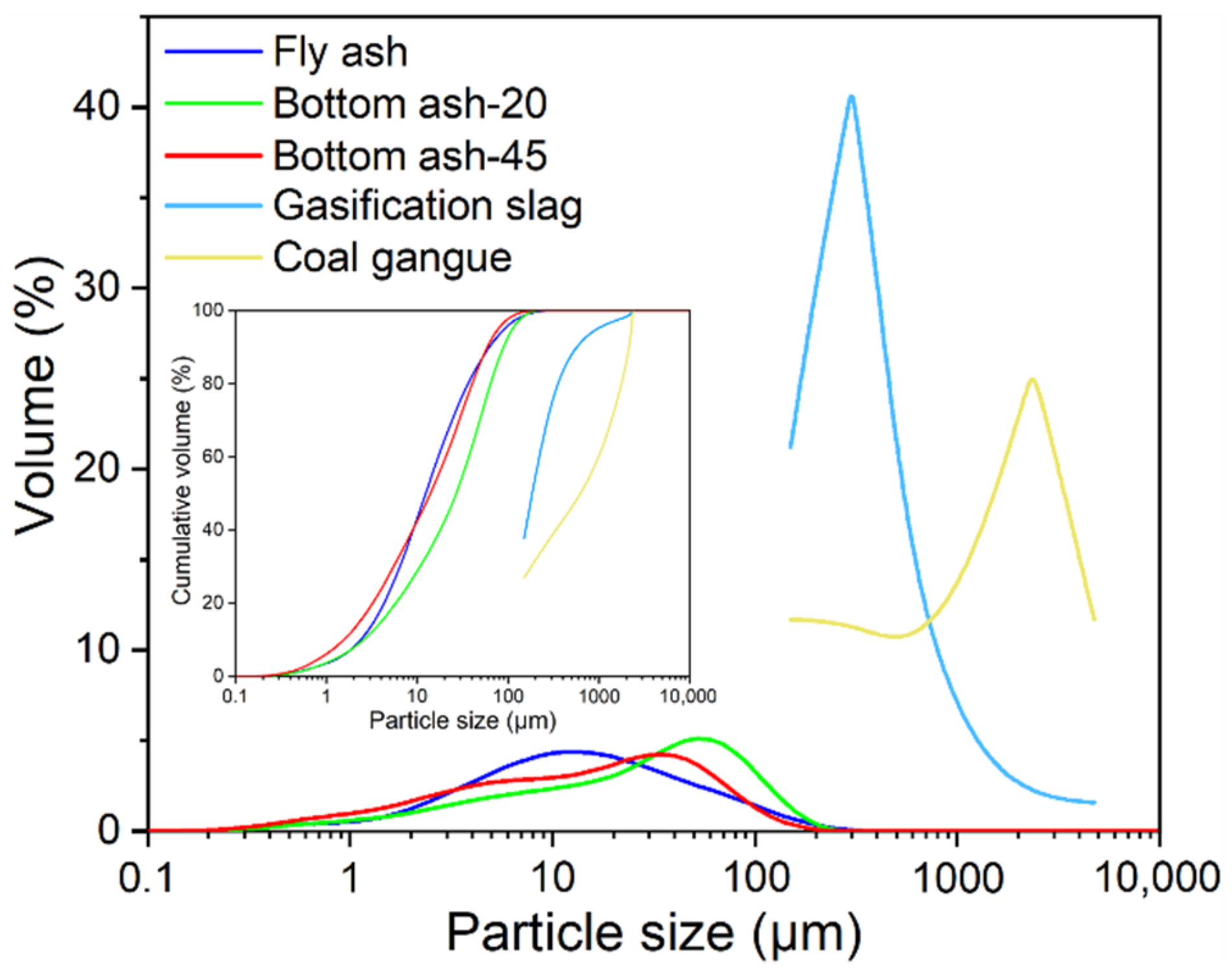


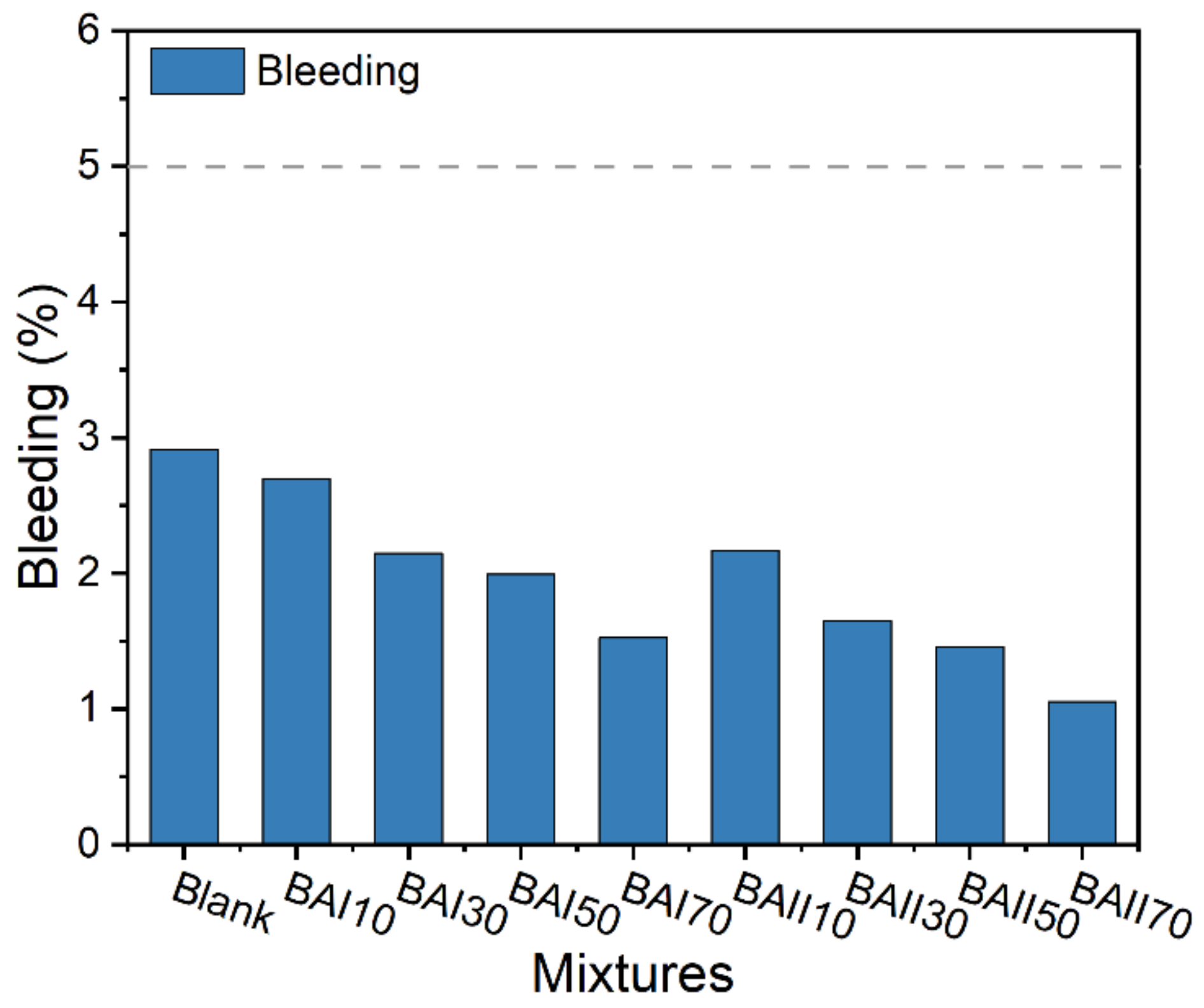
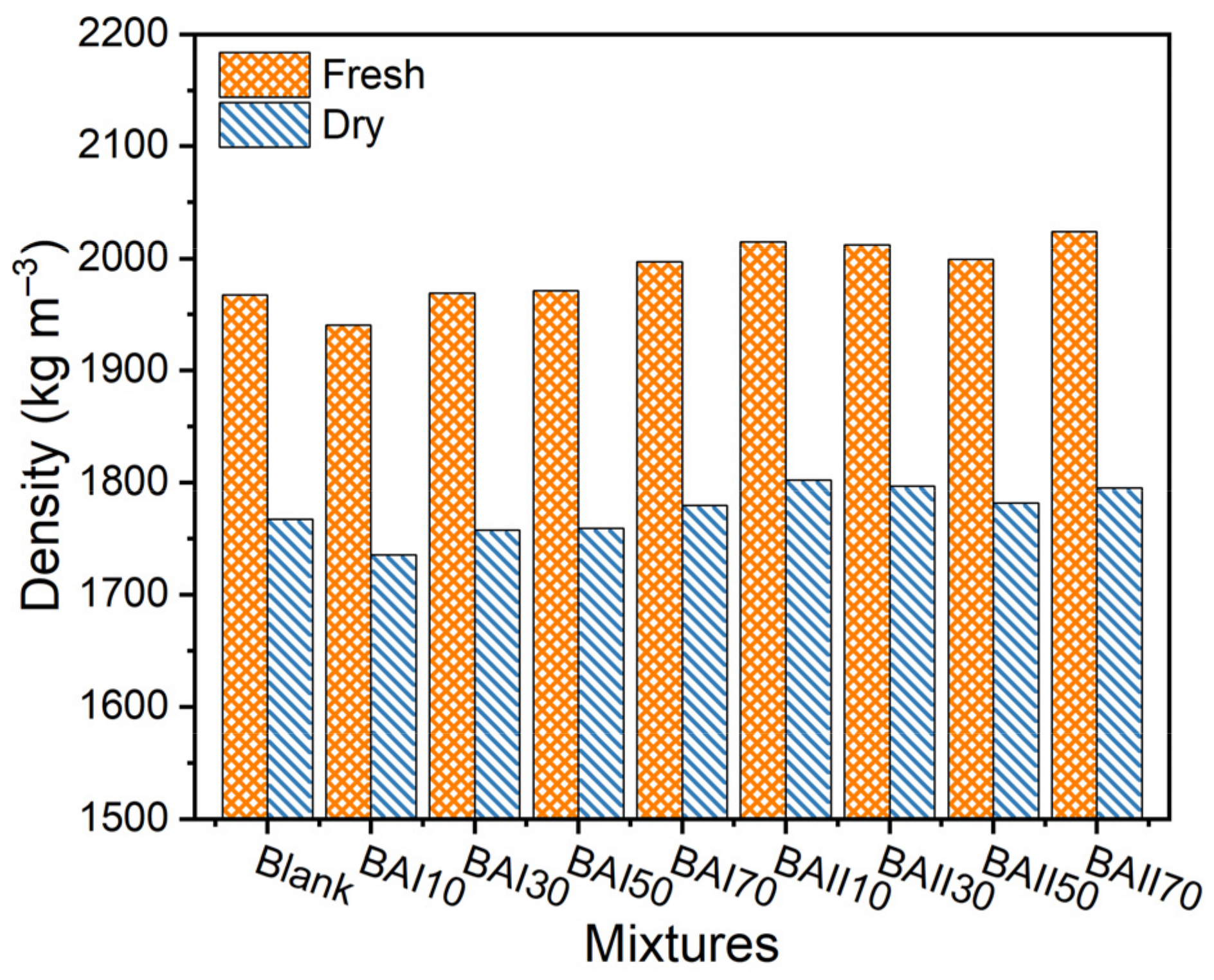

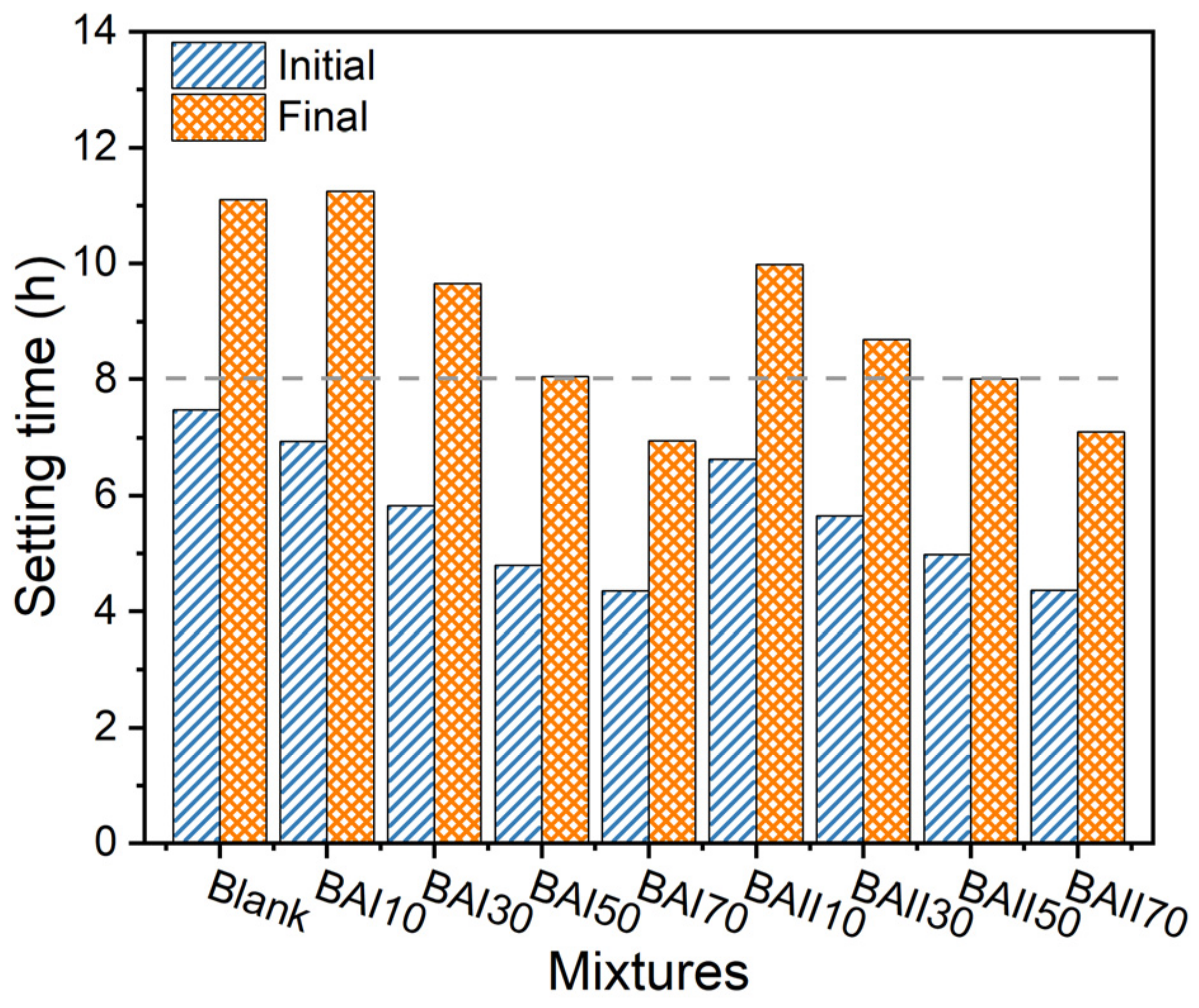


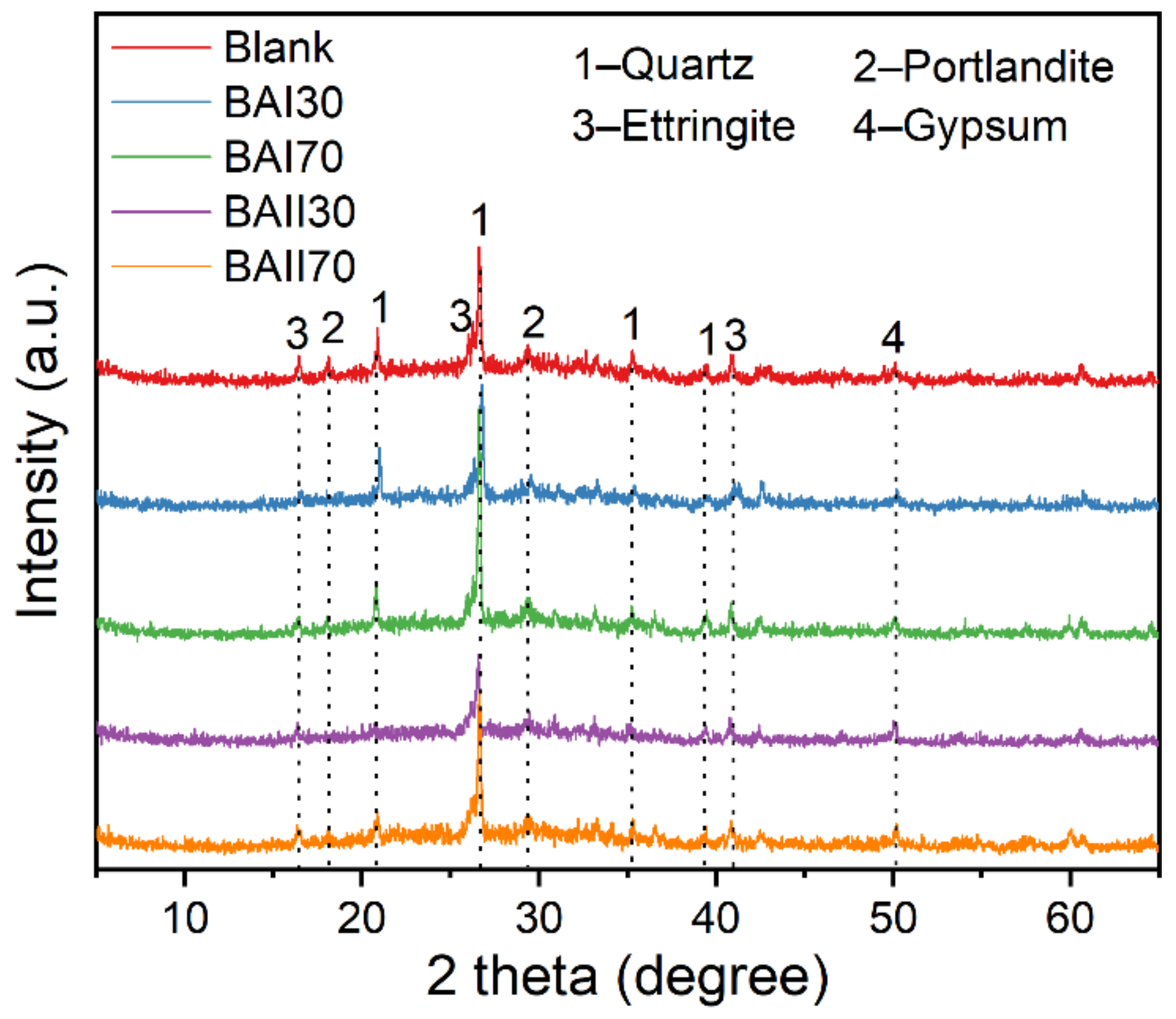
| Compound | Cement | Bottom Ash | Fly Ash | Desulfurized Gypsum | Gasification Slag | Coal Gangue |
|---|---|---|---|---|---|---|
| SiO2 | 20.72 | 56.37 | 52.95 | 2.62 | 48.07 | 48.46 |
| Al2O3 | 4.62 | 26.71 | 27.55 | 0.58 | 16.37 | 24.13 |
| CaO | 62.18 | 3.41 | 4.94 | 28.77 | 8.95 | 0.10 |
| Fe2O3 | 3.26 | 6.62 | 6.31 | 0.43 | 8.84 | 9.44 |
| MgO | 3.15 | 1.20 | 1.92 | 2.46 | 1.91 | 0.47 |
| Na2O | 0.52 | 1.08 | 1.52 | 0.25 | 1.77 | 0.25 |
| K2O | 0.34 | 1.58 | 1.85 | 0.12 | 1.48 | 1.99 |
| TiO2 | − | 1.04 | 1.28 | 0.03 | 0.90 | 0.86 |
| SO3 | 2.72 | 0.47 | 1.03 | 40.17 | 0.61 | 0.09 |
| f-CaO | 0.72 | − | − | − | − | − |
| Cl− | 0.012 | − | − | − | − | − |
| Loss | 1.84 | 1.09 | 0.19 | 24.50 | 10.30 | 14.03 |
| Mixture | Aggregate (kg m−3) | Cementitious Materials (kg m−3) | Water (kg m−3) | Water-Reducing Agent (kg m−3) | ||||
|---|---|---|---|---|---|---|---|---|
| Coal Gangue | Gasification Slag | Cement | Fly Ash | Bottom Ash | Desulfurized Gypsum | |||
| Blank | 960 | 240 | 80 | 304 | 0 | 16 | 280 | 0.8 |
| BAI10 | 960 | 240 | 80 | 273.6 | 30.4 | 16 | 280 | 0.8 |
| BAI30 | 960 | 240 | 80 | 212.8 | 91.2 | 16 | 280 | 0.8 |
| BAI50 | 960 | 240 | 80 | 152 | 152 | 16 | 280 | 0.8 |
| BAI70 | 960 | 240 | 80 | 91.2 | 212.8 | 16 | 280 | 0.8 |
| BAII10 | 960 | 240 | 80 | 273.6 | 30.4 | 16 | 280 | 0.8 |
| BAII30 | 960 | 240 | 80 | 212.8 | 91.2 | 16 | 280 | 0.8 |
| BAII50 | 960 | 240 | 80 | 152 | 152 | 16 | 280 | 0.8 |
| BAII70 | 960 | 240 | 80 | 91.2 | 212.8 | 16 | 280 | 0.8 |
| Test Procedure | Standard | References |
|---|---|---|
| Flowability | ASTM D6103-17 | [32] |
| Bleeding and fresh density | GB/T 50080-2016 | [33] |
| Compressive strength | GB/T 50081-2019 | [34] |
| Setting time | GB/T 1346-2011 | [35] |
| Absorption, porosity, and dry density | ASTM D6023-16 | [36] |
Publisher’s Note: MDPI stays neutral with regard to jurisdictional claims in published maps and institutional affiliations. |
© 2022 by the authors. Licensee MDPI, Basel, Switzerland. This article is an open access article distributed under the terms and conditions of the Creative Commons Attribution (CC BY) license (https://creativecommons.org/licenses/by/4.0/).
Share and Cite
Chen, T.; Yuan, N.; Wang, S.; Hao, X.; Zhang, X.; Wang, D.; Yang, X. The Effect of Bottom Ash Ball-Milling Time on Properties of Controlled Low-Strength Material Using Multi-Component Coal-Based Solid Wastes. Sustainability 2022, 14, 9949. https://doi.org/10.3390/su14169949
Chen T, Yuan N, Wang S, Hao X, Zhang X, Wang D, Yang X. The Effect of Bottom Ash Ball-Milling Time on Properties of Controlled Low-Strength Material Using Multi-Component Coal-Based Solid Wastes. Sustainability. 2022; 14(16):9949. https://doi.org/10.3390/su14169949
Chicago/Turabian StyleChen, Tianxiang, Ning Yuan, Shanhu Wang, Xinfei Hao, Xinling Zhang, Dongmin Wang, and Xuan Yang. 2022. "The Effect of Bottom Ash Ball-Milling Time on Properties of Controlled Low-Strength Material Using Multi-Component Coal-Based Solid Wastes" Sustainability 14, no. 16: 9949. https://doi.org/10.3390/su14169949
APA StyleChen, T., Yuan, N., Wang, S., Hao, X., Zhang, X., Wang, D., & Yang, X. (2022). The Effect of Bottom Ash Ball-Milling Time on Properties of Controlled Low-Strength Material Using Multi-Component Coal-Based Solid Wastes. Sustainability, 14(16), 9949. https://doi.org/10.3390/su14169949






